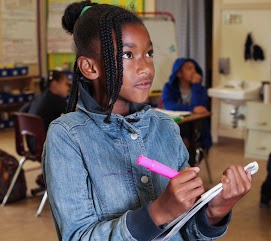What is formative assessment? Link to this section
"Formative assessment is a systematic process to continuously gather evidence about learning" (Heritage, 2007).
 It means assessing what your learners know and taking that into account as you plan the next activities. However, the most effective way to implement formative assessment is to involve students as active participants (Cauley & McMillan, 2010; Heritage, 2007).
It means assessing what your learners know and taking that into account as you plan the next activities. However, the most effective way to implement formative assessment is to involve students as active participants (Cauley & McMillan, 2010; Heritage, 2007).
One process of doing this is to identify specific misunderstandings, provide feedback to students to guide them to correct their own errors, and then shift instruction to fill any gaps (Cauley & McMillan, 2010).
Identifying gaps Link to this section
There are many ways to assess learners for gaps in understanding, and they can be on the fly, part of a teacher's plan, or pre-set in the curriculum (Heritage, 2007). They can also take almost any form but need to be low-stakes assessments because they are meant to provide evidence for instructional decisions, not to penalize a student or bring down their grade.
Almost any tool can be used for identifying gaps, depending on the type of evidence the instructor is seeking and/or the task given to learners. Some tools, however, can make mass collection of the evidence a little easier.
 Google Forms can be configured to work like a quiz, and the score can be communicated to the learner or kept for the teacher only. Learn more about Google Forms and Quizzes.
Google Forms can be configured to work like a quiz, and the score can be communicated to the learner or kept for the teacher only. Learn more about Google Forms and Quizzes.- Slides can be used to create interactive settings where each student is assigned an identical slide to manipulate objects to demonstrate understanding. Learn more about using Slides for 1x1 activities.
- Use Google Classroom to have students submit work. Leave comments and feedback, and students can resubmit their work after addressing errors. Learn more about grading and feedback in Google Classroom.
Giving feedback Link to this section
 There are many ways to give feedback on digital work. Feedback should be timely, frequent, and specific, but it shouldn't just give the learner all the answers either (Dolan, Kain, Reilly & Bansal, 2017). Rather, it should guide them to learn from their own mistakes. Feedback can be delivered verbally or in writing, and the delivery method may depend on the learner or on the circumstance.
There are many ways to give feedback on digital work. Feedback should be timely, frequent, and specific, but it shouldn't just give the learner all the answers either (Dolan, Kain, Reilly & Bansal, 2017). Rather, it should guide them to learn from their own mistakes. Feedback can be delivered verbally or in writing, and the delivery method may depend on the learner or on the circumstance.
The following graphic comes from the Australian Society for Evidence Based Teaching's article on effective feedback.

Self-assessment Link to this section
 Learners can be highly adept at assessing their own performance in certain circumstances, especially if scaffolded appropriately. While there are many ways to prompt and collect students' self assessments, Google Forms can be used to gather data in one convenient place. Learn more about creating Google Forms.
Learners can be highly adept at assessing their own performance in certain circumstances, especially if scaffolded appropriately. While there are many ways to prompt and collect students' self assessments, Google Forms can be used to gather data in one convenient place. Learn more about creating Google Forms.
Take a look at Jennifer Roberts' blog post about using Google Forms for self evaluation. Then check out Lauren Borrerro's complimentary post on self assessment in Google Forms.
References Link to this section
Cauley, K. M., & McMillan, J. H. (2010). Formative assessment techniques to support student motivation and achievement. The Clearing House, 83(1), 1-6.
Dolan, J. , Kain, K., Reilly, J., & Bansal, G. (2017). How Do You Build Community and Foster Engagement in Online Courses?. Teaching and Learning, 2017(151), 45-60.
Heritage, M. (2007). Formative assessment: What do teachers need to know and do? Phi Delta Kappan, 89(2), 140-145.
This page was last updated on March 9, 2021

